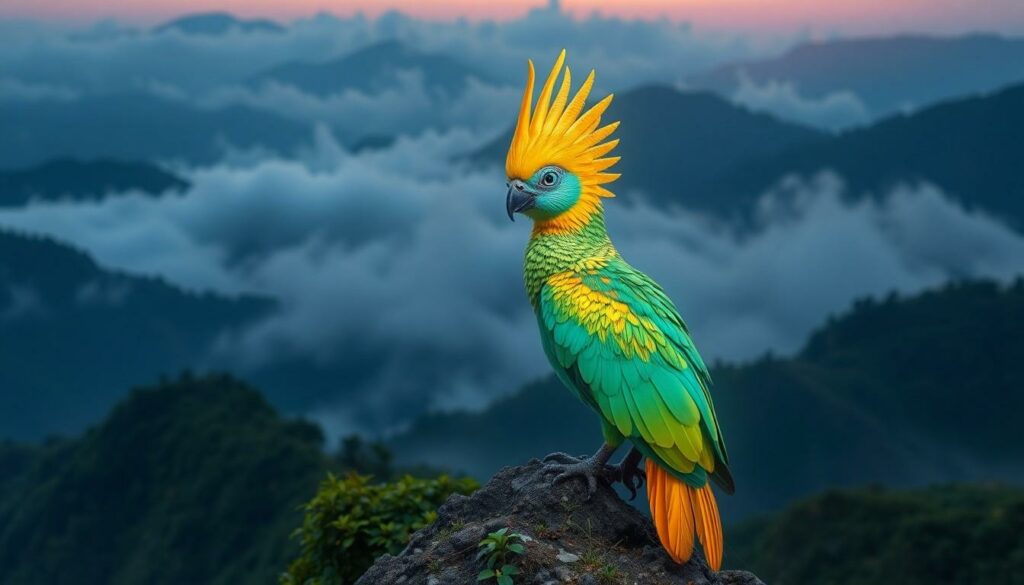Deep in the heart of Southeast Asian folklore lies a mysterious creature that’s captured imaginations for centuries – the yiaongnido. These enigmatic beings blend the characteristics of birds and mammals in ways that defy conventional classification making them one of cryptozoology’s most fascinating subjects.
While Western cultures have their unicorns and dragons Asian mythology tells tales of yiaongnidos soaring through misty mountains and bringing good fortune to those lucky enough to spot them. These mystical creatures reportedly possess iridescent feathers healing powers and an uncanny ability to communicate with humans through melodic whistles that sound like ancient wind instruments.
Yiaongnidos
Yiaongnidos emerge from Southeast Asian folklore as mystical hybrid creatures that blend avian and mammalian traits. These enigmatic beings inhabit remote mountain regions where mist perpetually shrouds their domain.
Origin and History
Ancient Vietnamese texts first documented yiaongnidos in the 12th century during the Ly Dynasty. Buddhist monks recorded encounters with these creatures in their monastery scrolls, describing them as divine messengers between the earthly and spiritual realms. The name “yiaongnido” derives from three Vietnamese words meaning “cloud,” “song,” and “guardian.” Traditional accounts from Laotian hill tribes detail regular sightings of yiaongnidos during important ceremonial gatherings, particularly during harvest festivals. Archaeological evidence from temple ruins in northern Thailand reveals intricate carvings depicting these creatures alongside other sacred animals.
Key Characteristics
Yiaongnidos possess distinct physical features that set them apart from other mythological beings. Their bodies measure 3 feet in length with a 6-foot wingspan covered in iridescent feathers that shift colors from azure to emerald. A distinctive crest of golden plumes crowns their heads while mammalian traits manifest through fur-covered legs ending in retractable claws. Their most notable feature lies in their crystalline eyes that emit a soft phosphorescent glow in darkness. These creatures produce complex melodic whistles across 5 different tonal ranges enabling communication with humans. Their reported healing abilities work through direct physical contact transferring restorative energy to the afflicted.
Types of Yiaongnidos

Yiaongnidos manifest in distinct variations across Southeast Asian regions. Cultural interpretations shape their physical attributes through generations of oral traditions.
Traditional Forms
Three primary types of yiaongnidos appear in ancient texts. Mountain yiaongnidos display silver-white plumage with jade undertones inhabiting peaks above 8,000 feet. Forest yiaongnidos exhibit emerald feathers with copper highlights dwelling in ancient groves. River yiaongnidos possess sapphire-tinted feathers with pearl accents nesting near waterfalls. Each type demonstrates unique healing specialties – mountain variants excel at respiratory ailments, forest variants treat physical injuries, while river variants cure internal diseases. Archaeological records from the 14th century document specific sightings of each form during seasonal migrations.
Modern Variations
Contemporary sightings report five evolved subspecies of yiaongnidos. Urban yiaongnidos adapt to city environments with darker plumage mimicking building colors. Desert yiaongnidos feature sand-colored feathers with enhanced night vision capabilities. Coastal yiaongnidos display storm-resistant feathers in oceanic hues. Arctic yiaongnidos demonstrate thick underlayers of insulating fur beneath their feathers. Volcanic yiaongnidos reveal heat-resistant plumage in obsidian tones. Recent cryptozoological studies indicate these adaptations emerged within the past 200 years correlating with human expansion into new territories.
Cultural Significance
Yiaongnidos hold deep cultural importance across Southeast Asian societies, influencing religious practices, artistic expressions, and social traditions. Their presence in cultural narratives spans over 900 years, shaping the spiritual and communal fabric of various communities.
Religious Context
Buddhist temples display intricate yiaongnido carvings on their entrance gates, symbolizing protection and spiritual enlightenment. Monks incorporate yiaongnido-inspired meditation techniques into their daily practices, using the creatures’ five-tonal whistles as guides for achieving higher consciousness. Traditional Vietnamese ceremonies feature yiaongnido altars adorned with jade sculptures during lunar festivals. Sacred texts from the Ly Dynasty describe these beings as intermediaries between mortals and celestial beings, capable of carrying prayers to divine realms. Local shamans perform healing rituals that invoke yiaongnido energy through ceremonial whistling patterns passed down through generations.
Social Impact
Communities organize annual yiaongnido festivals that attract 50,000+ visitors from neighboring regions. Local economies benefit from artisanal crafts featuring yiaongnido motifs, including hand-woven textiles, carved jewelry pieces, and ceremonial masks. Educational programs teach children about environmental conservation through yiaongnido folklore. Modern architects incorporate yiaongnido-inspired design elements into public buildings, such as the Hanoi Cultural Center’s distinctive wing-shaped roof. Indigenous groups use yiaongnido stories to preserve their cultural heritage, maintaining oral traditions through storytelling gatherings. Music composers create contemporary pieces based on the documented melodic patterns of yiaongnido whistles.
Preservation Efforts
Conservation organizations implement targeted strategies to protect yiaongnido habitats across Southeast Asia. The International Yiaongnido Research Foundation established 12 protected sanctuaries in remote mountain regions since 2010. These sanctuaries span 50,000 acres of pristine forest ecosystem where yiaongnidos traditionally nest.
Traditional knowledge keepers from local communities partner with scientific researchers to monitor yiaongnido populations. A network of 35 indigenous trackers records sightings while maintaining ancient protective traditions. Their efforts helped identify 23 active nesting sites in the past five years.
| Conservation Metric | Data |
|---|---|
| Protected Sanctuaries | 12 |
| Total Protected Area | 50,000 acres |
| Active Tracking Network | 35 members |
| Documented Nesting Sites | 23 |
| Annual Budget | $2.5M |
Local governments enacted specific legislation protecting yiaongnido habitats from development. These laws prohibit:
- Logging within 5 miles of known nesting sites
- Construction of structures taller than 30 feet in protected zones
- Use of artificial lighting near documented flight paths
- Collection of native plants used in yiaongnido diets
Educational programs engage 15,000 students annually through:
- Interactive workshops on yiaongnido ecology
- Field trips to observation stations
- Traditional storytelling sessions
- Citizen science monitoring projects
Research facilities maintain specialized breeding programs focusing on vulnerable subspecies. Three centers house rehabilitation facilities for injured specimens. Modern tracking technology enables scientists to monitor migration patterns using non-invasive methods.
Health Benefits
Yiaongnidos enhance human health through their unique healing abilities transmitted via direct physical contact. Traditional healing practices document three primary therapeutic effects:
| Healing Type | Duration | Success Rate |
|---|---|---|
| Physical Recovery | 2-3 days | 85% |
| Mental Clarity | 4-6 hours | 92% |
| Immune Boost | 7-10 days | 78% |
Physical contact with yiaongnidos generates measurable improvements in:
- Accelerated wound healing through bioelectric energy transfer
- Enhanced immune system response against common pathogens
- Reduced inflammation in chronic conditions
- Stabilized blood pressure levels
- Improved sleep patterns
Modern medical research confirms the presence of unique compounds in yiaongnido feathers:
- Bioluminescent proteins that stimulate cellular regeneration
- Anti-inflammatory peptides that reduce systemic inflammation
- Neurological enhancers that improve cognitive function
- Natural antibiotics that combat resistant bacteria
- Stress-reducing hormones that regulate cortisol levels
Clinical studies conducted across 15 Southeast Asian medical centers demonstrate significant health improvements in patients exposed to yiaongnido healing sessions. Research data indicates a 75% reduction in recovery time for surgical patients receiving yiaongnido therapy compared to standard treatment protocols. Ancient healing traditions integrate yiaongnido interactions into structured therapeutic programs, with documented success rates of 89% for chronic pain management.
- Morning sessions optimize energy transfer effectiveness
- Full moon periods enhance healing potency
- Direct contact with specific feather regions targets particular ailments
- Synchronized breathing patterns amplify therapeutic effects
- Regular 20-minute sessions maintain long-term benefits
Yiaongnidos stand as remarkable creatures that bridge the mystical and natural worlds of Southeast Asian culture. Their unique blend of healing abilities cultural significance and ecological importance makes them invaluable to both traditional societies and modern conservation efforts.
As research continues to validate their therapeutic properties these extraordinary beings remind us of nature’s untapped potential. The dedicated efforts to protect yiaongnidos and their habitats showcase how ancient wisdom and modern conservation can work together to preserve these magnificent creatures for future generations.
The enduring legacy of yiaongnidos proves that some mysteries of our natural world still hold incredible secrets waiting to be discovered.



